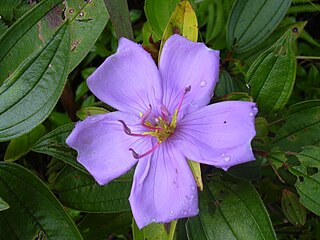
Melastoma is a genus in the family Melastomataceae. It has over 100 species distributed around Southeast Asia, India, north to Japan, south to Australia and the Pacific Islands. The number of species should probably be reduced according to some sources. Many species have been planted around the world for the aesthetic value of their bright purple flowers.

Melastoma affine, also known by the common names blue tongue or native lassiandra, is a shrub of the family Melastomataceae. Distributed in tropical and sub-tropical forests of India, South-east Asia and Australia, it is a plant of rainforest margins. Bees are the principal pollinators of this species.

Agrotera nemoralis, the beautiful pearl, is a species of moth of the family Crambidae. It was first described by Giovanni Antonio Scopoli in his 1763 Entomologia Carniolica.

Agrotera is a genus of snout moths in the subfamily Spilomelinae of the family Crambidae. It is the type genus of the tribe Agroterini and currently comprises 28 species distributed in the Afrotropical, Palearctic, Indomalayan and Australasian realm.
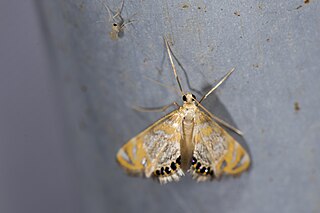
Nymphicula is a genus of moths of the family Crambidae.
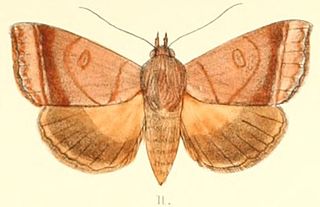
Ophiusa trapezium is a moth of the family Erebidae first described by Achille Guenée in 1852. It is found from the Indo-Australian tropics of India, Sri Lanka to Queensland, the Bismarck Islands and New Caledonia. Adults are fruit piercers.
Melastoma denticulatum is a species of flowering plant in the family Melastomataceae, native from the Solomon Islands to the south Pacific.
Meganola brunellus is a moth of the family Nolidae. It is found in Sri Lanka, India, Taiwan, Japan, the Ryukyu Islands, Sundaland, Queensland and the Bismarck Islands. It is an introduced species in Hawaii.

Ategumia adipalis is a moth of the family Crambidae described by Julius Lederer in 1863. It is found from India to Australia and in Japan, Sri Lanka, Vietnam and China. It was introduced to Hawaii in 1965.
Ategumia fatualis is a moth of the family Crambidae described by Julius Lederer in 1863. It is native to Java and the Philippines, but was introduced to Hawaii and Kauai in 1958 for the control of Melastoma malabathricum.
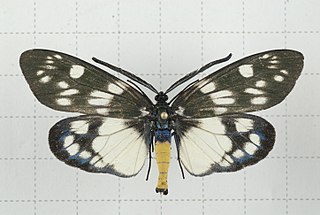
Eterusia aedea, the red slug caterpillar, is a species of moth in the family Zygaenidae. It was described by Carl Linnaeus in his 1763 Centuria Insectorum. It is found in Sri Lanka, India, Nepal, Taiwan, Japan and China.

Gatesclarkeana idia is a moth of the family Tortricidae. It is found in Japan, Taiwan, China, Indonesia, Thailand and Vietnam.

Melastoma malabathricum, known also as Malabar melastome, Indian rhododendron, Singapore rhododendron, planter's rhododendron and senduduk, is a flowering plant in the family Melastomataceae. Despite its common names, it does not have any connection to actual rhododendrons, and belongs to the Rosids clade as opposed to the Asterids clade. This plant is native to Indomalaya, Japan and Australia, and is usually found at elevations between 100 m and 2,800 m in grassland and sparse forest habitats. It has been used as a medicinal plant in certain parts of the world, but has been declared a noxious weed in the United States. M. malabathricum is a known hyperaccumulator of aluminium, and as such can be used for phytoremediation.
Homona eductana is a species of moth of the family Tortricidae. It is found in India, Thailand, Malaysia, Singapore and China.
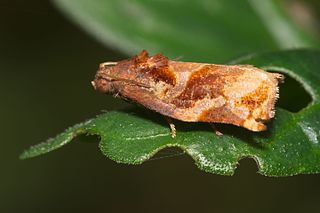
Homona tabescens is a species of moth of the family Tortricidae. It is found in south-east Asia, where it has been recorded from Java, Sabah, China, Thailand, Malaysia, New Guinea and Vietnam.

Agrotera endoxantha is a moth in the family Crambidae. It was described by George Hampson in 1898. It is found in New Guinea.
Agrotera fumosa is a moth in the family Crambidae. It was described by George Hampson in 1899. It is found in the Democratic Republic of the Congo, Ghana and Ivory Coast.
Agrotera ignepicta is a moth in the family Crambidae. It was described by George Hampson in 1899. It is found in Australia, where it has been recorded in Queensland.
Agrotera setipes is a moth in the family Crambidae. It was described by George Hampson in 1898. It is found in Indonesia, where it has been recorded from the Natuna Islands.
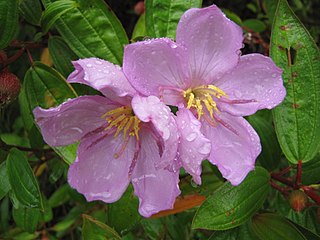
Melastoma septemnervium are erect shrubs or small slender trees with 5 petal, medium-sized, pink flowers that have made them attractive for cultivation. The leaves have the 5 distinctive longitudinal veins (nerves) typical of plants in the family Melastomataceae.











